Kentucky‘s lush landscapes are not only a feast for our eyes but also a haven for many caterpillars. These intriguing critters inch their way to becoming beautiful butterflies or moths. However, it’s important to note that amidst the harmless majority, there are a few that come bearing stings and toxins.
Whether you’re an avid gardener, an outdoor enthusiast, or a parent of curious kids, being informed about the caterpillars you might encounter is crucial. So, without further ado, let’s dive in deep and get to know 20 caterpillars found in Kentucky!
1. Monarch Caterpillar (Danaus plexippus)

Monarch caterpillars eat milkweed.
©Cathy Keifer/Shutterstock.com
During the springtime, adult monarch butterflies journey northward, and Kentucky is one of their destinations. Here, female butterflies choose milkweed plants to lay their eggs on. Monarch caterpillars sport distinctive stripes in shades of yellow, black, and white. These caterpillars feature tentacle-like projections on both ends of their bodies. Before transforming into a butterfly, they can grow up to two inches long.
Interestingly, the only food source for these caterpillar larvae is milkweed leaves. Nature has crafted a special relationship where these leaves, though filled with toxins, are harmless to the caterpillars. Yet, those same toxins deter potential predators, making these caterpillars dangerous to consume. It’s crucial to note that these creatures carry potent toxins and can be harmful.
2. Cabbageworm Caterpillar (Pieris rapae)
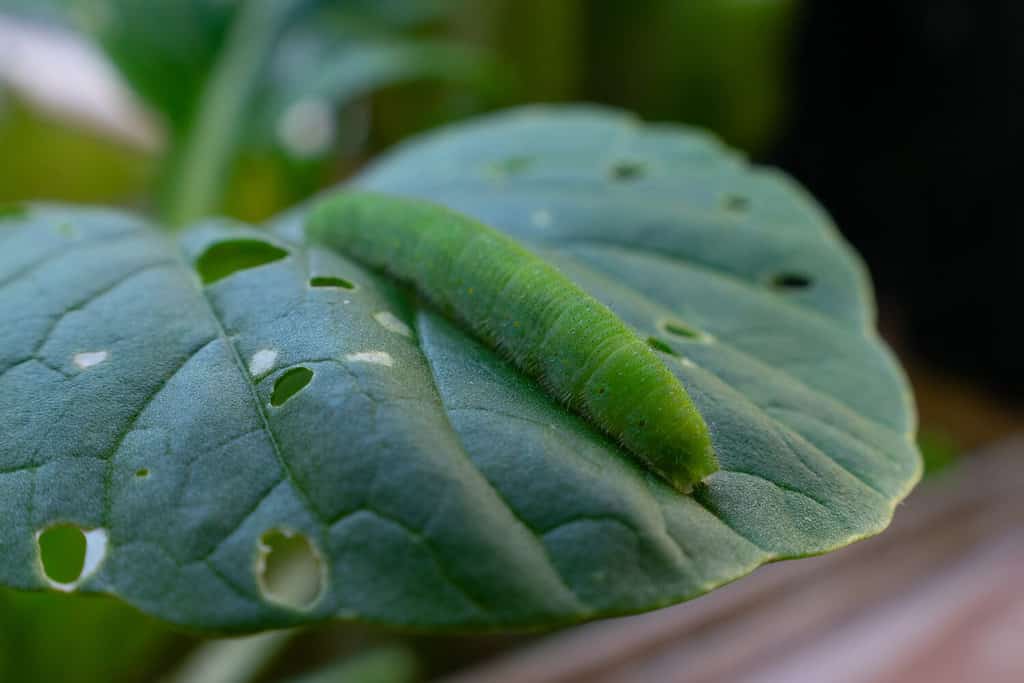
The cabbageworm is completely harmless.
©Kelsey Armstrong Creative/Shutterstock.com
In Kentucky, people commonly refer to the cabbageworm as the imported cabbageworm due to its origins outside North America. These caterpillars are notorious for being a nuisance to farmers as they can cause significant damage to their preferred plants. These caterpillars boast a green hue, complemented by fine hairs that render their skin a soft, plush texture. As they mature, they can grow close to an inch long.
Their primary diet consists of plants from the Cruciferae family, though occasionally, they nibble on other plants known for their mustard oils.
These caterpillars are completely harmless!
3. Io Caterpillar (Automeris io)

One of the stinging caterpillars in Kentucky is the io moth.
©Andy Reago & Chrissy McClarren / CC BY 2.0 – License
The io moth caterpillar boasts a light green to yellow hue, distinguished by a thin red stripe along its side, underscored by a white line. As it grows, it can reach two inches and is adorned with yellow spines tipped with black.
This caterpillar enjoys munching on various plants, such as hackberry, willow, mesquite, redbud, currant, blackberry, and pear. Generally, you’ll find them in areas like deciduous forests, thorny bushes, or even suburban zones.
Approach the io moth caterpillar with caution! It’s poisonous and can deliver a painful sting. A mere touch can cause its spines to lodge in your skin, potentially causing hours of discomfort.
4. Spotted Apatelodes Caterpillar (Apatelodes torrefacta)

A beautiful white in color, approach the spotted apatelodes caterpillar with caution!
©Jacy Lucier / CC BY-SA 4.0 – License
The young spotted apatelodes caterpillar sports a pristine white color, but as it matures, it transforms into a vibrant shade of neon yellow. This color makes it easily noticeable against the backdrop of green leaves or the rugged bark of a tree. This caterpillar stands out further, with distinct tufts of long black bristles sprouting behind its head and near its tail.
Its preferred diet includes leaves from trees like ash, cherry, maple, and oak, among other hardwoods.
Though not poisonous, some people might experience allergic reactions upon contact with the spotted apatelodes caterpillar’s hair. So, approach with caution!
5. Monkey Slug Caterpillar (Phobetron hipparchia)
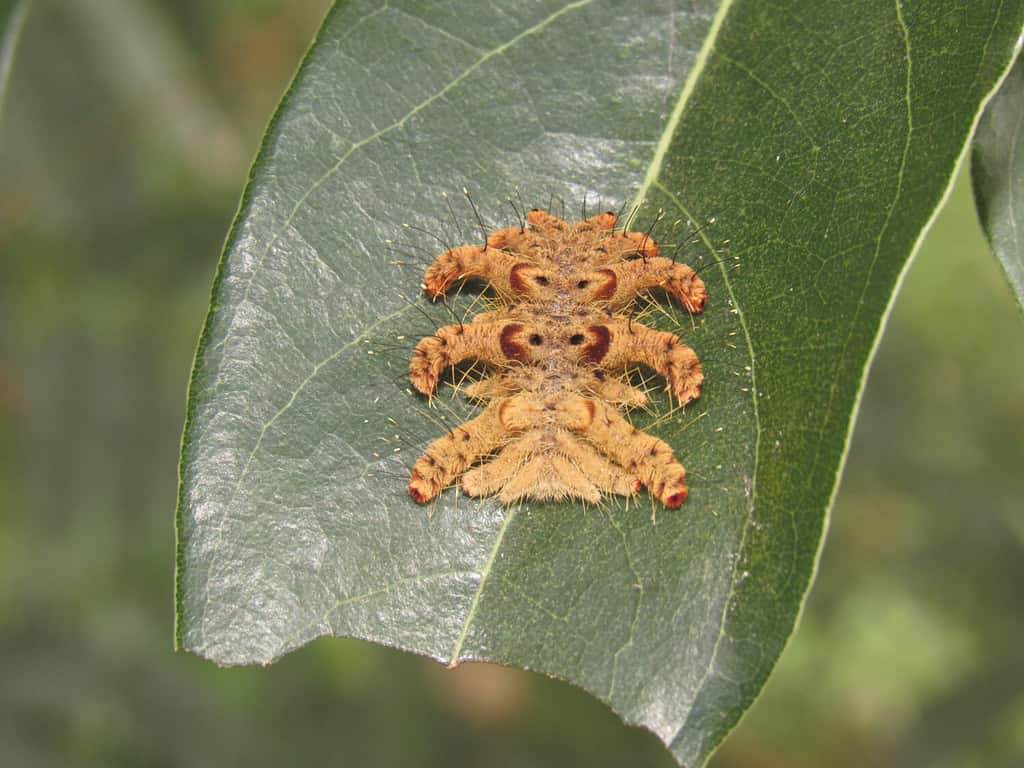
A unique-looking caterpillar in Kentucky is the monkey slug!
©Fabio Ara/Shutterstock.com
The monkey slug isn’t your typical caterpillar. Resembling a fuzzy, elongated, brown starfish, this unique caterpillar is the larval form of the hag moth. Instead of the usual prolegs, they’re equipped with suckers, giving them a slug-like movement.
These caterpillars usually reside and munch on the leaves of various trees and bushes, including chestnut, dogwood, hickory, oak, and willow, often hiding underneath.
Despite its eerie appearance suggesting danger, the monkey slug caterpillar poses little to no threat to humans.
6. Cecropia Moth Caterpillar (Hyalophora cecropia)

Although it may look harmful, the cecropia moth is actually safe to handle.
©K Hanley CHDPhoto/Shutterstock.com
The cecropia moth caterpillar spends most of the summer growing, reaching a length of up to four inches when it’s fully grown. It sports a vibrant bluish-green hue, with pairs of yellow bumps adorning its back on every segment.
These caterpillars have a diverse diet, munching on the foliage of various trees and shrubs such as ash, birch, box elder, and elm.
Though the cecropia moth caterpillar isn’t harmful, its quirky appearance might deter some potential threats.
7. Spicebush Swallowtail Caterpillar (Papilio troilus)
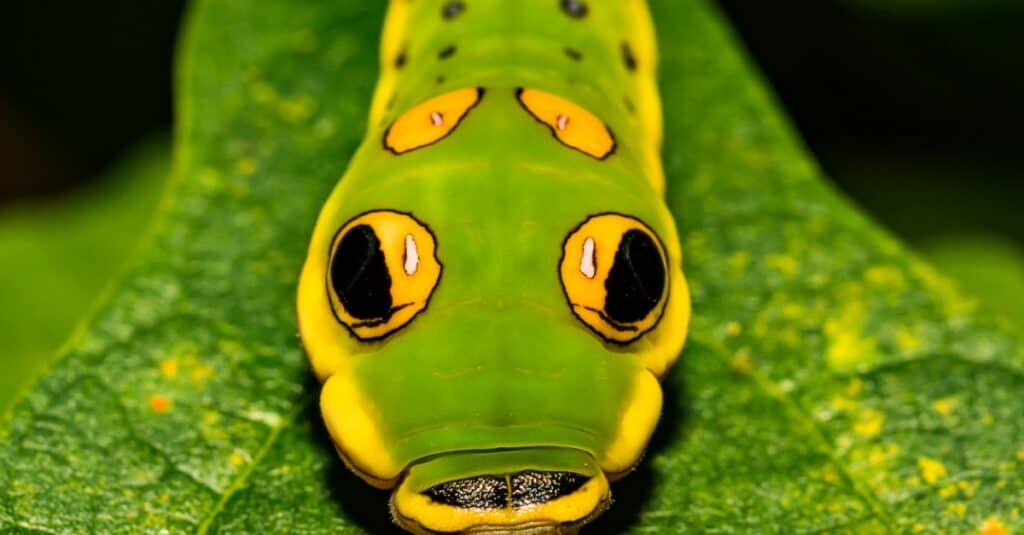
The disguise of the spicebush swallowtail caterpillar makes it look like a snake!
©iStock.com/JasonOndreicka
The spicebush swallowtail caterpillar has a fascinating transformation in its appearance: it starts resembling bird waste and then develops what looks like the eyes of a snake! This clever disguise helps it stay safe from hungry foes. Its favorite meals come from the leaves of plants like the sweet bay, spicebush, sassafras, and tulip trees.
Despite flaunting a set of intimidating eye-like patterns, the spicebush swallowtail caterpillar is entirely harmless.
8. Banded Tussock Caterpillar (Halysidota tessellaris)
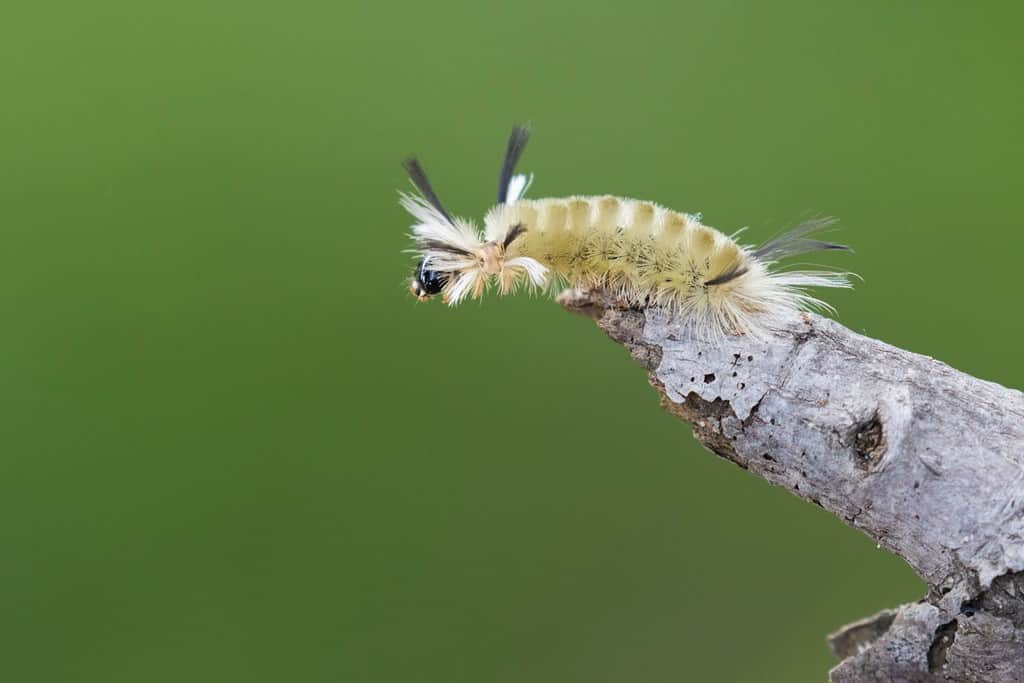
Coming in shades of white and orange, the banded tussock moth caterpillar can cause a rash.
©Mircea Costina/Shutterstock.com
The banded tussock moth caterpillar is easily recognizable by its soft, pale hairs interspersed with tufts of white and shades of orange. These caterpillars are commonly spotted in the latter part of summer and early fall. They feast on a variety of trees and shrubs, including ash, oak, walnut, and even plants like grapes and willow.
While they draw curiosity due to their unique appearance, it’s essential to handle them with caution. Their bristly hairs can cause an irritating rash, though they aren’t poisonous.
9. Tobacco Hornworm Caterpillar (Manduca sexta)
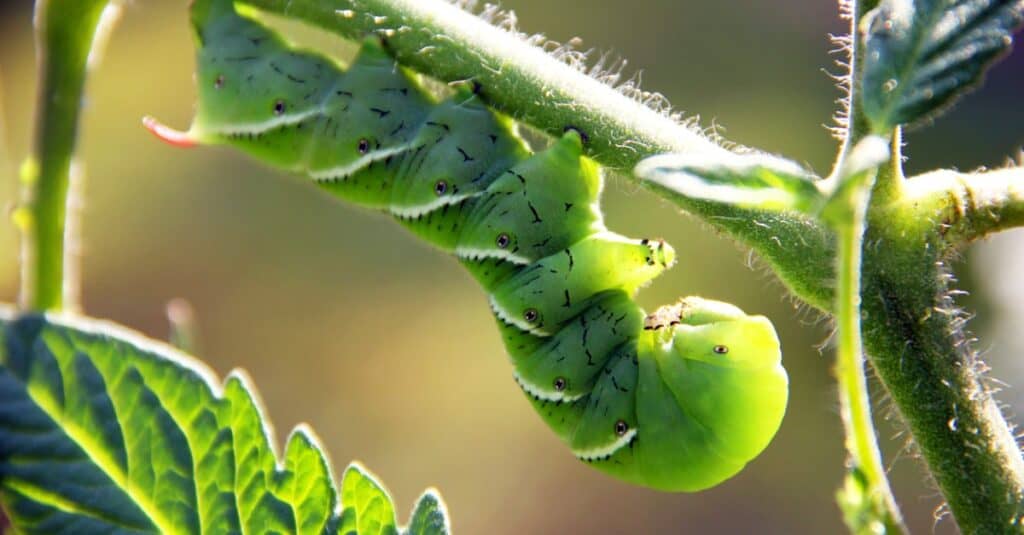
These caterpillars are completely safe to handle.
©iStock.com/lauraag
The tobacco hornworm caterpillar boasts a vivid green hue accented by diagonal white stripes and features a small, horn-like nub on its rear end. Among the caterpillars in Kentucky, this one often spells trouble. Its favorite meals include tobacco, tomatoes, and similar plants, making it a significant concern for farmers.
Despite their menacing look, these caterpillars are safe to handle; they don’t bite or sting.
10. Curve-Lined Owlet Moth Caterpillar (Phyprosopus callitrichoides)

This caterpillar has a very interesting body structure.
©Judy Gallagher / CC BY 2.0 – License
The curve-lined owlet moth caterpillar is a sight to behold with its unique body structure, seeming almost segmented with a pronounced bend at its center. It has a white, saddle-like mark in the middle and sports an impressively long horn-like structure at its front. Their diet is pretty specific; they primarily feed on greenbrier plants.
Despite their peculiar appearance, they pose no harm to humans.
11. Woolly Bear Caterpillar (Pyrrharctia isabella)
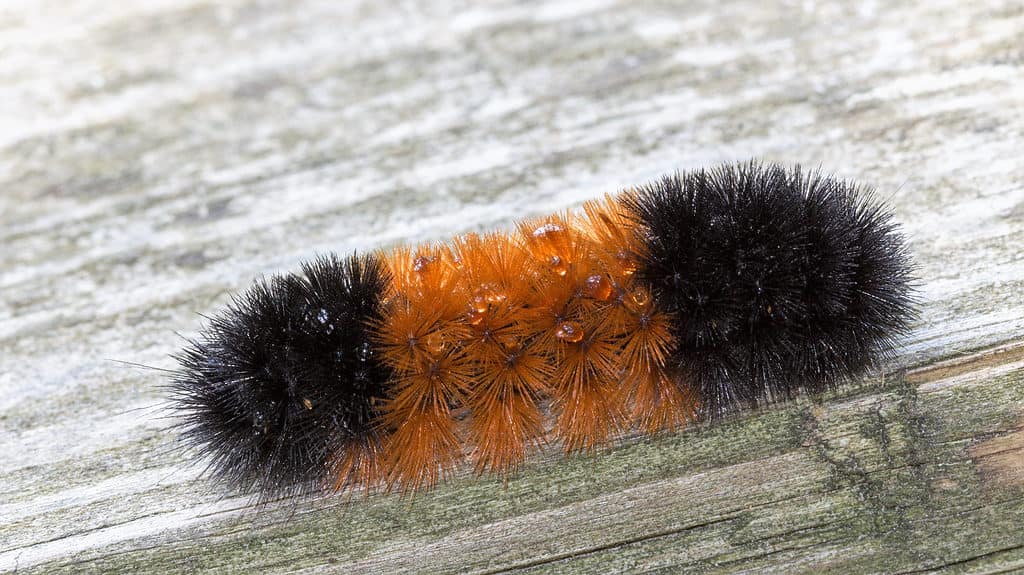
This hairy caterpillar is safe to handle.
©Kimberly Boyles/Shutterstock.com
The woolly bear caterpillar is easily recognizable with its 13 clear segments that display shades of deep black or rusty brown. Typically, the ends are black with a rust-colored band in the center, though some might lean more toward one color. These caterpillars are members of the “tiger moth” family. Preferring low-growing wild vegetation, they’re often found munching on plants like dandelion, aster, and dock.
While some hairy caterpillars can have harmful, stinging bristles, the black and brown woolly bears are safe and non-toxic to handle.
12. Yellow-Necked Caterpillar (Datana ministra)
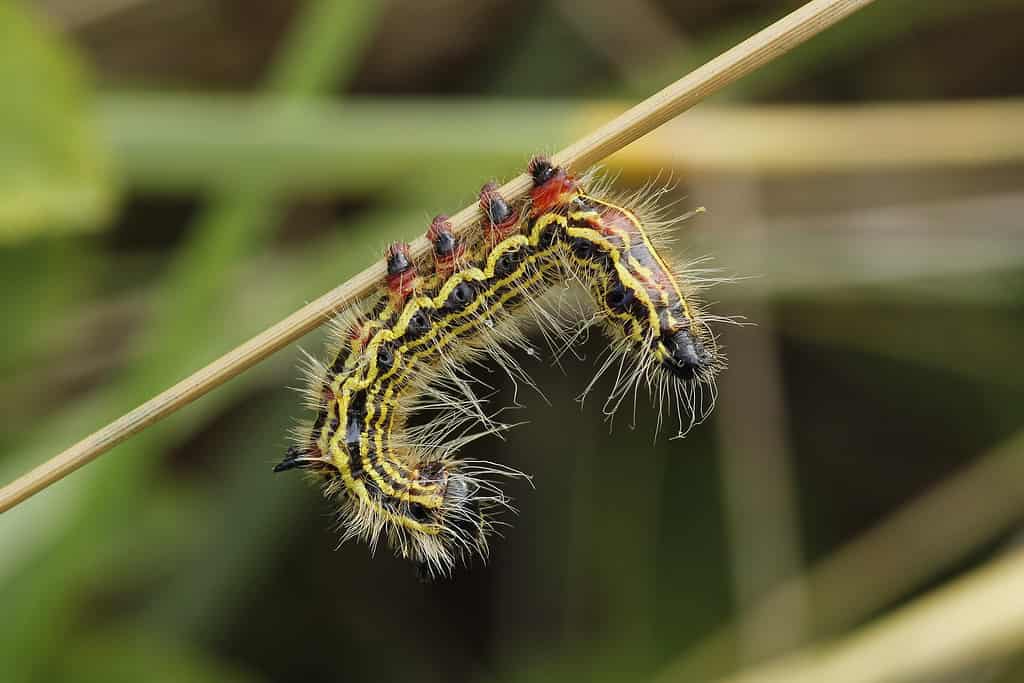
Safe to handle, the yellow-necked caterpillar is found on shade trees and shrubs.
©BrianLasenby/ via Getty Images
The yellow-necked caterpillar is aptly named for its distinct yellow band encircling its neck, although it sometimes takes on shades of brown or orange. Starting with a black head, its body transforms in color as it grows, beginning as a light green with reddish blotches in its early stages.
Often found on shade trees and shrubs, this caterpillar likes various trees like oak, birch, maple, and even fruit trees like apple and blueberry, making it a notorious pest in some regions.
Despite their intimidating appearance, there’s no cause for alarm. They are completely safe and won’t harm humans through bites or stings.
13. Southern Flannel Moth Caterpillar (Megalopyge opercularis)
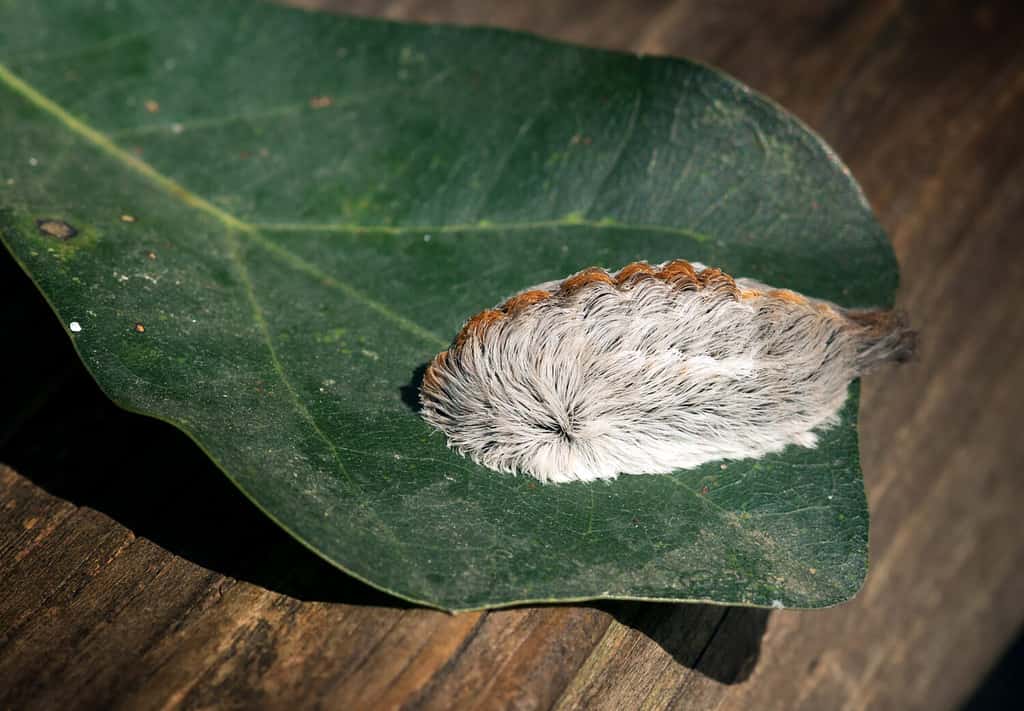
Although the southern flannel moth caterpillar may look furry and soft, it has venomous spines.
©IrinaK/Shutterstock.com
The southern flannel moth caterpillar boasts a range of colors, from soft grayish-white and golden hues with vibrant orange streaks to deep, smoky gray. In its younger days, this caterpillar sports particularly curly “fur,” enhancing its plush appearance. This little critter has quite the appetite, feasting on crops such as corn and tobacco. Notably, oak tree leaves are also on its menu.
However, don’t be deceived by its soft exterior; this caterpillar hides venomous spines beneath its fluff. Touching them can lead to an intensely painful skin reaction, so it’s best to admire them from a distance.
14. Walnut Caterpillar (Datana integerrima)
Walnut caterpillars sport a black hue adorned with long, white to grayish hairs. During June, these critters often hatch from egg clusters laid on leaves, which means you might find several of them sharing a tree.
Their peak feeding months are June and July, and their appetite can strip leaves off smaller to mid-sized trees. Their palate is diverse, munching on various trees and woody plants, with pecan, walnut, and hickory being some of their favorites.
While they may look intriguing, there’s no cause for alarm – they neither sting nor carry toxins.
15. Stinging Rose Caterpillar (Parasa indetermina)
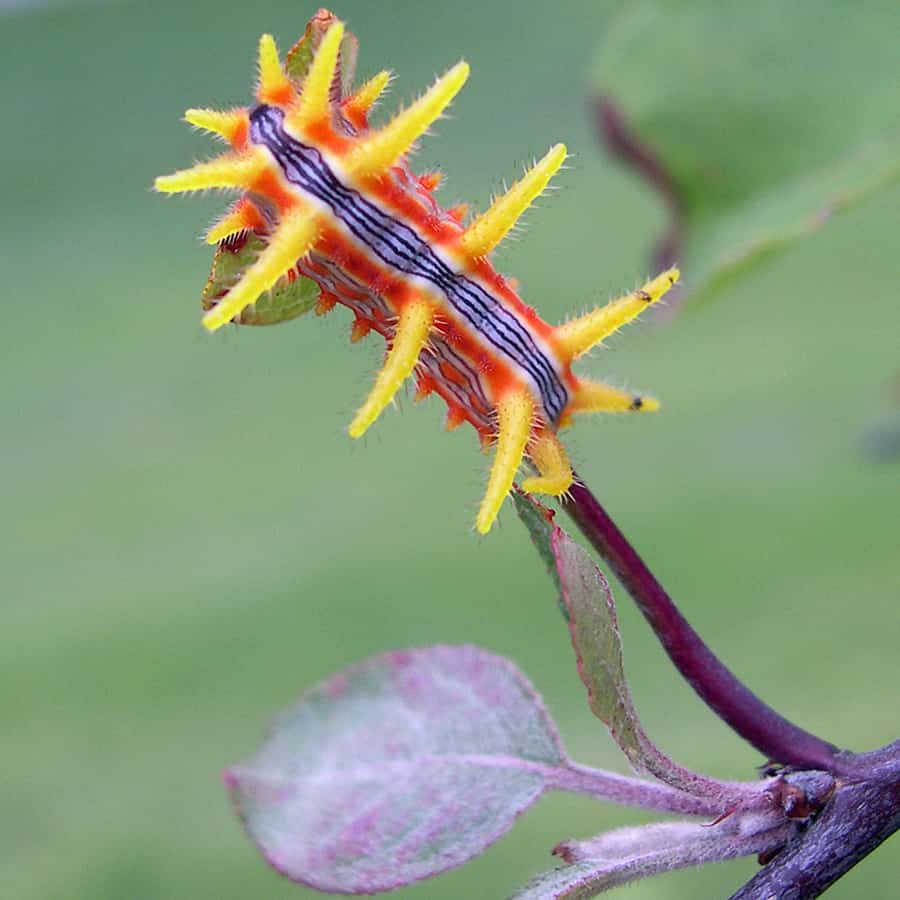
A colorful caterpillar, the stinging rose caterpillar has spines filled with poison.
©M. Whitson / CC BY 4.0 – License
Stinging rose caterpillars showcase a vibrant palette of red, yellow, and orange colors, adorned with hints of purple and cream stripes. These colorful critters are roughly the size of an inch. They’re often spotted feeding on oak, redbud, hickory, wild cherry, bayberry, and sycamore, typically residing on shrubs or lower tree branches.
Distinguishing them are seven pairs of horn-like protrusions covered in spines and additional prickly bumps lining their sides. Each of these spines is hollow, filled with poison. When unsuspecting humans brush against these spines, the tips break, releasing this fluid and resulting in a stinging sensation.
16. Spun Glass Caterpillar (Isochaetes beutenmuelleri)
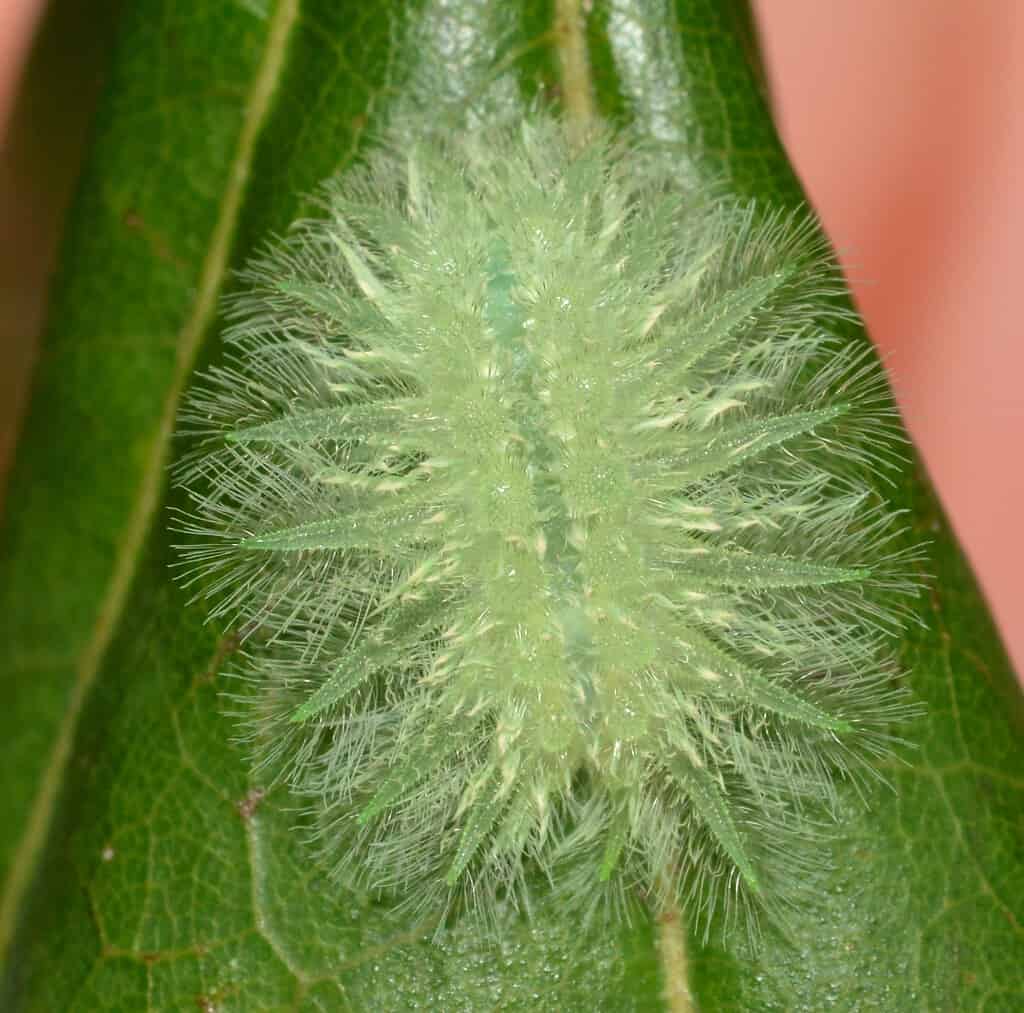
One of the most unique caterpillars in Kentucky is the spun glass caterpillar.
©Andy Reago & Chrissy McClarren / CC BY 2.0 – License
The spun glass caterpillar has a captivating, nearly see-through body adorned with radiant green spines. Its multiple tentacle-like arms, combined with its slow, deliberate movements, often draw comparisons to a squid, especially as it glides over its silky trail. Its primary food source is the swamp oak.
Despite its mesmerizing beauty, this caterpillar is a dangerous encounter. Coming into contact with its spines can lead to painful stings and severe skin reactions. Additionally, these prickles secrete a toxin, making the caterpillar a threat to both humans and other animals.
17. Spiny Elm Caterpillar (Nymphalis antiopa)
The spiny elm caterpillar measures around 2 inches and sports a predominantly black, prickly exterior dotted with tiny white spots. A line of red markings can be observed between its spines along its back. While they primarily dine on elm leaves, they’re also known to feed on willow, birch, cottonwood, and hackberry.
Caution is advised around this caterpillar as it possesses stinging spines. Direct contact can result in some of these sharp hairs embedding into the skin, causing sharp pain.
18. Saddleback Caterpillar (Acharia stimulea)
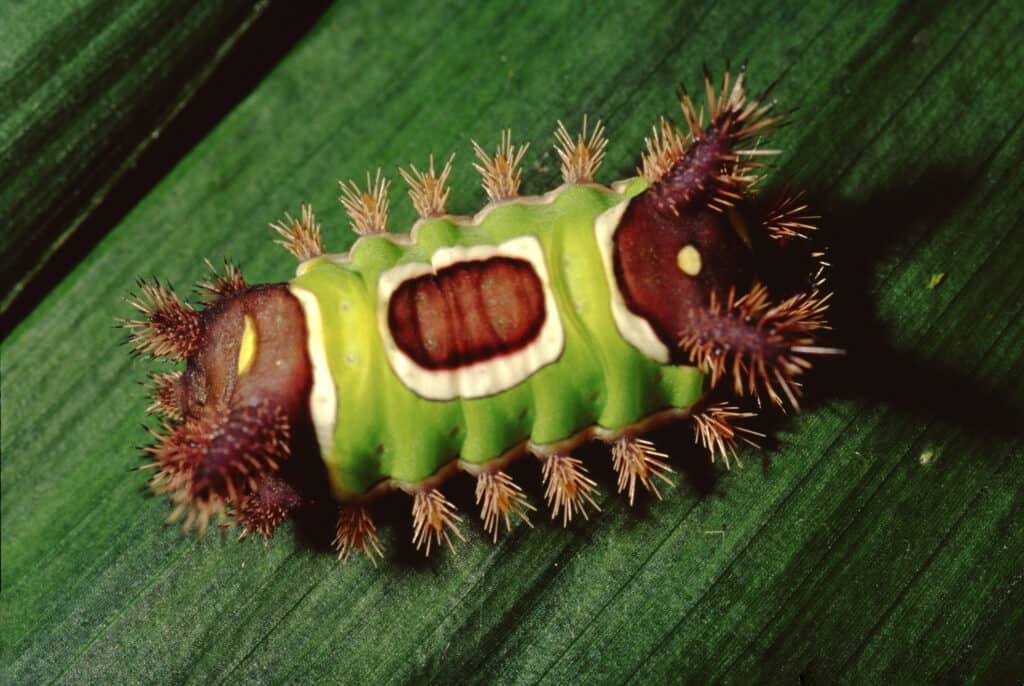
As its name suggests, the saddleback caterpillar has a “saddle”.
©Liz Weber/Shutterstock.com
The saddleback caterpillar is distinguishable by its unique green back, which is highlighted with a brown dot encircled in white. Its ends are brown, and its texture appears grainy, adorned with pairs of horn-like protrusions. At the larval stage, its body resembles that of a slug and measures about an inch.
Commonly spotted on deciduous trees like basswood, chestnut, cherry, oak, and plum, they’ve also been observed in significant numbers on corn.
Though its vibrant hues might intrigue, be warned: it’s poisonous!
19. Puss Caterpillar (Megalopyge opercularis)

The puss caterpillar is one of the most poisonous caterpillars in Kentucky.
©Chase D’animulls/Shutterstock.com
Among the most poisonous caterpillars in Kentucky is the puss caterpillar. At about an inch in length, its fuzzy exterior, ranging from tan to a pale gray, can be deceiving. Hidden beneath its soft-looking hairs are shorter, venom-filled spines. Their diet is primarily plant-based, munching on leaves from trees like poplar, sallow, and willow.
Though the puss caterpillar might look harmless, it carries venomous bristles. A brush against this critter can inflict severe pain, leading to blisters that persist for weeks.
20. Pipevine Swallowtail Caterpillar (Battus philenor)

This eye-catching caterpillar is toxic.
©Sundry Photography/Shutterstock.com
Pipevine swallowtail caterpillars are eye-catching with their black-purple hue, accented by vibrant orange spots. These caterpillars are not only a visual treat but are also unpalatable and toxic to potential predators, a trait they carry into their butterfly phase. Often dubbed blue swallowtails, their exclusive diet comprises the leaves of birthworts and Dutchman’s pipes.
Their ability to feed on the toxic pipevine plant, Aristolochia, gives them their distinct advantage. This plant harbors the potent poison known as aristolochic acid, which the caterpillars ingest and utilize as a defense mechanism.
Regions in Kentucky with the Most Caterpillars
Remember, while these regions are a paradise for caterpillar enthusiasts, always approach them with caution. Knowing which ones to avoid touching can make your exploration safe and enjoyable!
- Blanton Forest: As the state’s largest old-growth forest, Blanton Forest provides a rich ecosystem, nurturing diverse plant life that serves as a buffet for various caterpillar species.
- Daniel Boone National Forest: Encompassing over 700,000 acres, its vast stretches of woodlands with diverse flora make it an ideal home for many caterpillars.
- The Bluegrass Region: Known for its fertile soil, it supports lush vegetation, drawing in numerous caterpillar species.
- Land Between the Lakes: Located in the western part of the state, this region’s vast green stretches and water bodies make it a haven for diverse wildlife, including caterpillars.
- The Appalachian Mountains: The diverse plant species and cooler climate provide a perfect habitat for various caterpillar species, both common and rare.
Summary of Caterpillars Found in Kentucky
| Caterpillar | Type of Caterpillar | Stinging? | |
|---|---|---|---|
| 1 | Monarch Caterpillar | Butterfly | Yes |
| 2 | Cabbageworm Caterpillar | Butterfly | No |
| 3 | Io Caterpillar | Moth | Yes |
| 4 | Spotted Apatelodes Caterpillar | Moth | No |
| 5 | Monkey Slug Caterpillar | Moth | No |
| 6 | Cecropia Moth Caterpillar | Moth | No |
| 7 | Spicebush Swallowtail Caterpillar | Butterfly | No |
| 8 | Banded Tussock Caterpillar | Moth | No |
| 9 | Tobacco Hornworm Caterpillar | Moth | No |
| 10 | Curve-Lined Owlet Moth Caterpillar | Moth | No |
| 11 | Woolly Bear Caterpillar | Moth | No |
| 12 | Yellow-Necked Caterpillar | Moth | No |
| 13 | Southern Flannel Moth Caterpillar | Moth | Yes |
| 14 | Walnut Caterpillar | Moth | No |
| 15 | Stinging Rose Caterpillar | Moth | Yes |
| 16 | Spun Glass Caterpillar | Moth | Yes |
| 17 | Spiny Elm Caterpillar | Butterfly | Yes |
| 18 | Saddleback Caterpillar | Moth | Yes |
| 19 | Puss Caterpillar | Moth | Yes |
| 20 | Pipevine Swallowtail Caterpillar | Butterfly | Yes |
The photo featured at the top of this post is © Mircea Costina/Shutterstock.com
Thank you for reading! Have some feedback for us? Contact the AZ Animals editorial team.






